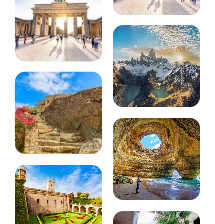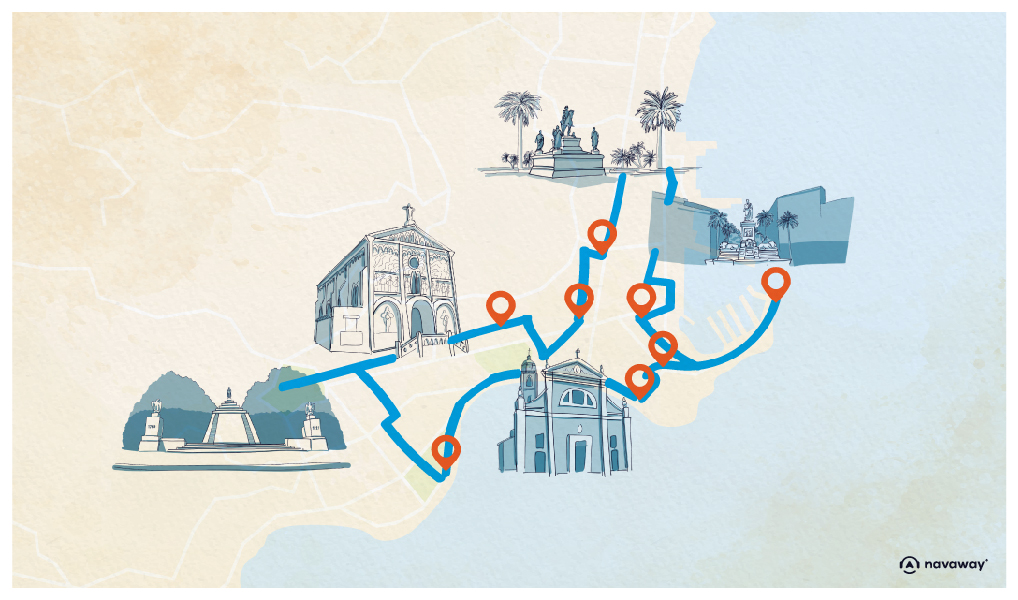
Corsica’s 10 most beautiful waterfalls for swimming
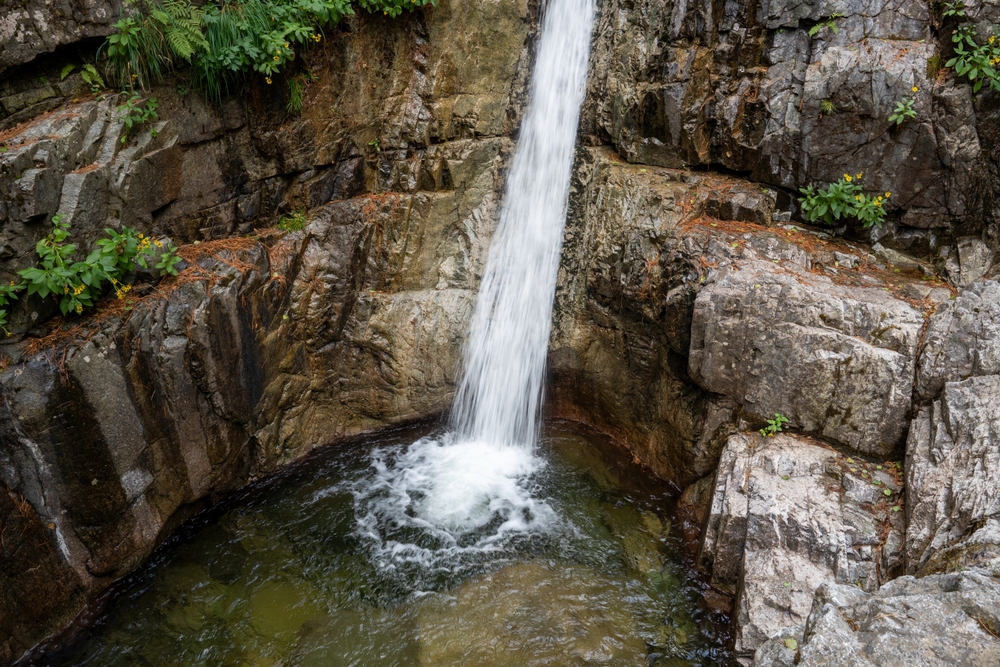
Between the turquoise sea and the rugged mountains, Corsica hides natural treasures of breathtaking beauty. Among them, the waterfalls and natural pools of the Isle of Beauty offer a refreshing alternative to the crowded beaches of summer. From the wild gorges of the Restonica to the crystal-clear pools of Purcaraccia, these exceptional natural sites promise unforgettable moments of relaxation in the heart of unspoilt nature. Whether you’re a hiking enthusiast or looking for an invigorating swim, discover our selection of the 10 most beautiful waterfalls to swim in in Corsica.

See also the Corsica guide :
- 15 excursions around Ajaccio
- The 10 most beautiful walks around Ajaccio
- The best places to visit in Haute-Corse
- The most beautiful villages in Corsica around Bastia
- Top 5 best holiday villages in Corsica
- Top 5 activities in Bastia
- Top 10 culinary specialities in Bastia
- Top 10 culinary specialities in Ajaccio
- Visit the Sanguinaires islands in Corsica
- Top 6 of the best Corsican campsites by the sea
1. The Purcaraccia waterfalls
Nestling in the heart of the Bavella massif, the Purcaraccia waterfalls are among the most spectacular in Corsica. This exceptional natural site offers a succession of natural pools carved out of the granite, linked by waterfalls up to 40 metres high. The crystal-clear water, constantly cool at around 15 degrees, contrasts magnificently with the glowing rocks heated by the sun.
The hike to these heavenly pools takes around 1? hours from the car park. The path, although sometimes rocky, remains accessible to experienced hikers. Once there, you’ll discover several deep pools ideal for swimming, natural slides for the more adventurous, and a breathtaking view of the Aiguilles de Bavella.
Access: From Porto-Vecchio, follow the D368 towards Zonza, then continue on the D268 to the Col de Bavella. The car park is at Bocca di Larone. Please note that access to the waterfalls is restricted from 1 July to 15 September and may require the presence of a professional guide.
2. The Polischellu waterfalls
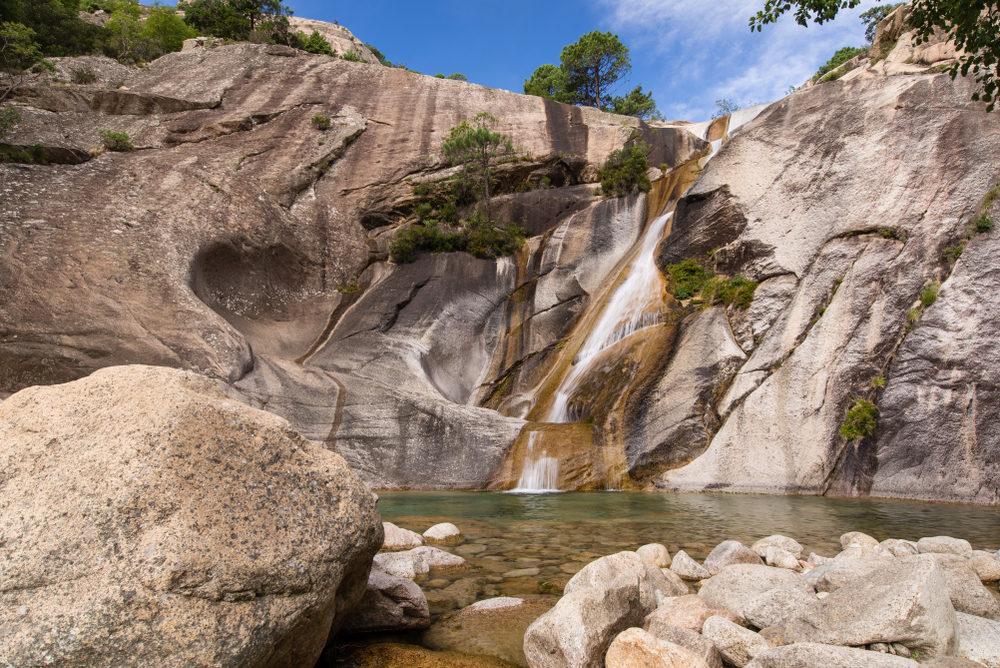
Just a few kilometres from Purcaraccia are the Polischellu waterfalls, another jewel in the Bavella massif. This is one of the most beautiful natural pools in southern Corsica, with pools of transparent water framed by granite walls sculpted by erosion. The area is particularly popular for canyoning, but lovers of a peaceful swim will also find much to enjoy here.
The first waterfall is easily accessible after a short walk from the tree-lined car park. For the more adventurous, it’s possible to head upstream to discover even more spectacular pools. The natural pools, carved out of the rock, offer a range of depths suitable for both children and experienced swimmers.
Access: From Zonza, take the D268 towards the Col de Bavella. The car park is located by the Polischellu bridge. As with Purcaraccia, access may be restricted in high season and you will need to be accompanied by an approved guide.
3. The natural pools of Cavu
Nicknamed “Les 3 Piscines”, the Cavu natural pools are one of Corsica’s most popular swimming spots. Located just 20 kilometres from Porto-Vecchio, they offer exceptionally pure turquoise waters, perfect for families with children. The current is virtually non-existent, so the little ones can enjoy themselves in complete safety.
The Cavu river meanders for 22 kilometres through lush vegetation, creating natural pools linked by small waterfalls. The high rocks give thrill-seekers the chance to do some jumping, while the natural slides are a delight for children. The water is slightly warmer than in the mountains, making swimming particularly pleasant even at the start of the season.
Access: From Porto-Vecchio, follow the D368 towards Zonza. After about 15 kilometres, you’ll find the Cavu natural pools car park on your right. A 15-minute walk will take you to the main pools.
4. The English waterfalls
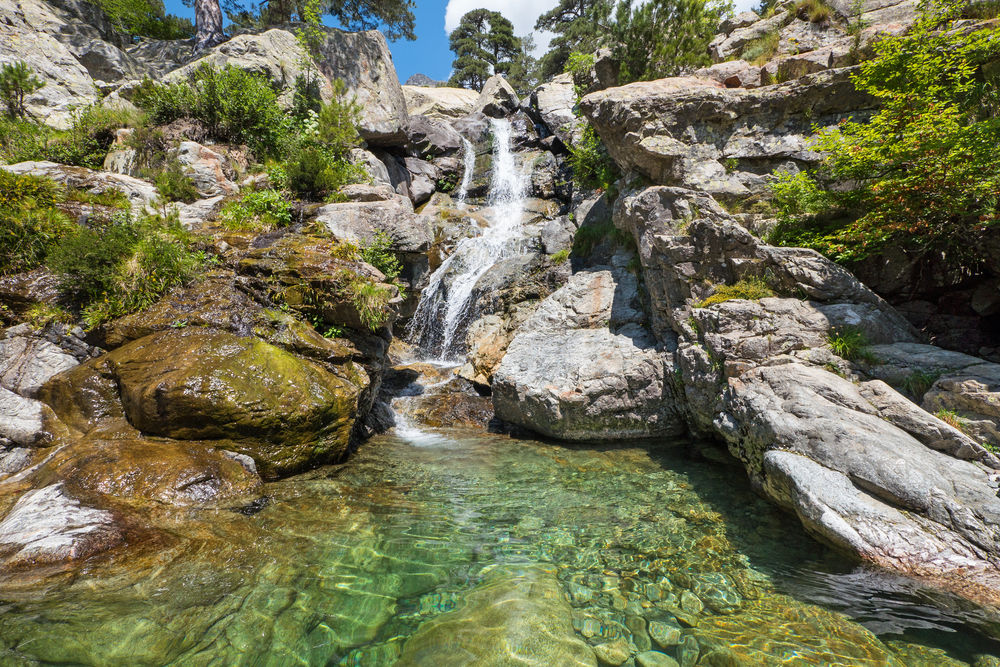
Situated in the Vizzavona forest, the Cascades des Anglais are a must for hikers on the GR20. This enchanting site has more than twenty waterfalls set in a landscape of hundred-year-old laricio pines. The deep pools of crystal-clear water offer a refreshing dip after a strenuous hike.
Relatively easy access from Vizzavona station makes it one of Corsica’s most popular waterfalls. Despite its popularity with tourists, the site retains all its natural charm. To take full advantage of the tranquillity of the site, it’s best to visit early in the morning or late in the afternoon, especially during the summer months.
Access: Meet at Vizzavona station, which is accessible via the RN193 between Corte and Ajaccio. A sign indicates the start of the path, which crosses two footbridges before reaching the waterfalls after a 20-minute walk. From the Vizzavona pass, it’s another 20-minute walk.
5. The Restonica gorges
Just a few kilometres from Corte, the Restonica gorges are one of Corsica’s most emblematic natural sites. Listed as a protected site since 1966, this spectacular valley boasts a breathtaking landscape where the river has sculpted countless natural pools in emerald and turquoise hues. There are plenty of opportunities for swimming here, from pools easily accessible by the roadside to more secret pools requiring a short hike.
The River Restonica rises in Lake Melo, at an altitude of 1,711 metres, guaranteeing pure, fresh water all year round. The rocks polished by time create white granite beaches ideal for lazing around, while the deep waters allow for swimming and even a few jumps off the rocks. If you’re looking to visit Corte, be sure to check out this natural wonder on the city’s doorstep.
Access: From Corte, follow the D623 along the Restonica valley. Numerous car parks line the road, providing easy access to the various bathing spots. In high season, a paying shuttle bus serves the valley from Corte (line C13).
6. The Piscia di Gallo waterfall
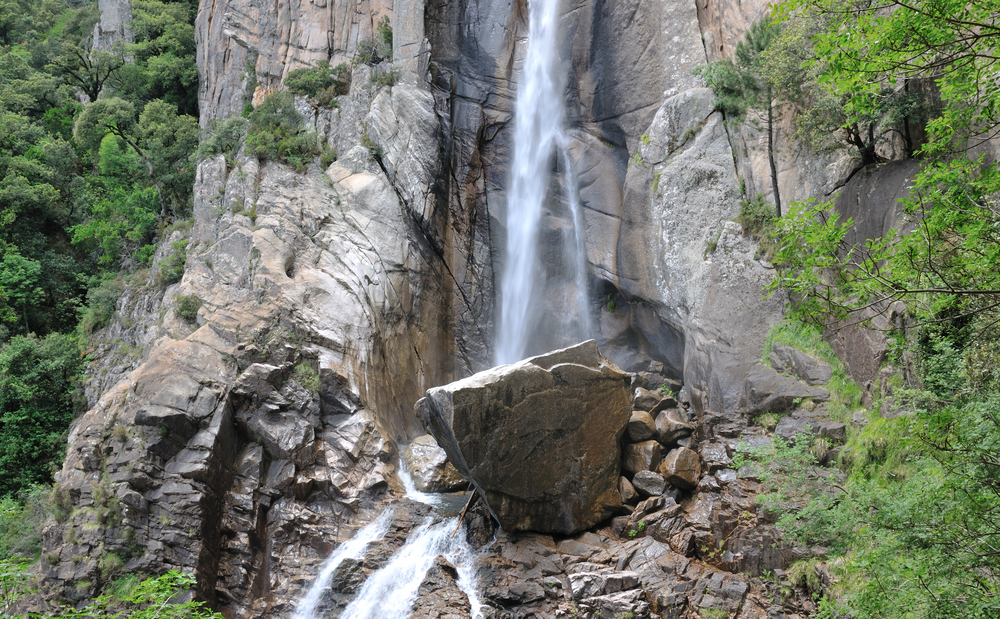
At 60 metres high, the Piscia di Gallo waterfall (literally “cock piss”) is one of the most impressive in Corsica. Located in the Ospedale forest, it is a breathtaking natural spectacle, with water rushing down into the void before joining a basin below. The path that leads to it passes through a magnificent pine forest, providing an enchanting backdrop for this 1h30 round trip hike.
Swimming at the foot of the waterfall is a unique experience, with the power of the water pouring down from the heights. The natural pool formed at the foot of the waterfall allows you to swim in cool, invigorating water, surrounded by the rocky walls of the Atta Roca. The site is particularly spectacular in spring, when the flow is at its maximum after the snow has melted.
Access: From Lac de l’Ospedale, follow the D368. The car park is about 1 kilometre before the lake, clearly signposted. It’s a 45-minute to 1-hour walk to the waterfall.
7. The Ucellulin cascade
Between the villages of San Nicolao and Santa Maria Poggio, the Ucelluline waterfall offers a natural spectacle that is unique in Corsica. This waterfall cascades straight down the mountain slopes into the sea. The site, crossed by two tunnels dug into the rock, has a wild, unspoilt character that is the source of its charm.
The natural pools at the foot of the waterfall offer a refreshing dip in crystal-clear water. Good walking shoes are essential, as the path can be slippery in places. In the evening, the waterfall is illuminated, providing a magical spectacle that can be seen from the coastal road. This makes it one of the few waterfalls in Corsica that can be admired at night.
Access: The waterfall is located between San Nicolao and Santa Maria Poggio on the east coast. The Pianelli car park is the starting point for accessing the site on foot. Allow around 15 minutes’ walk.
8. The Radule waterfall
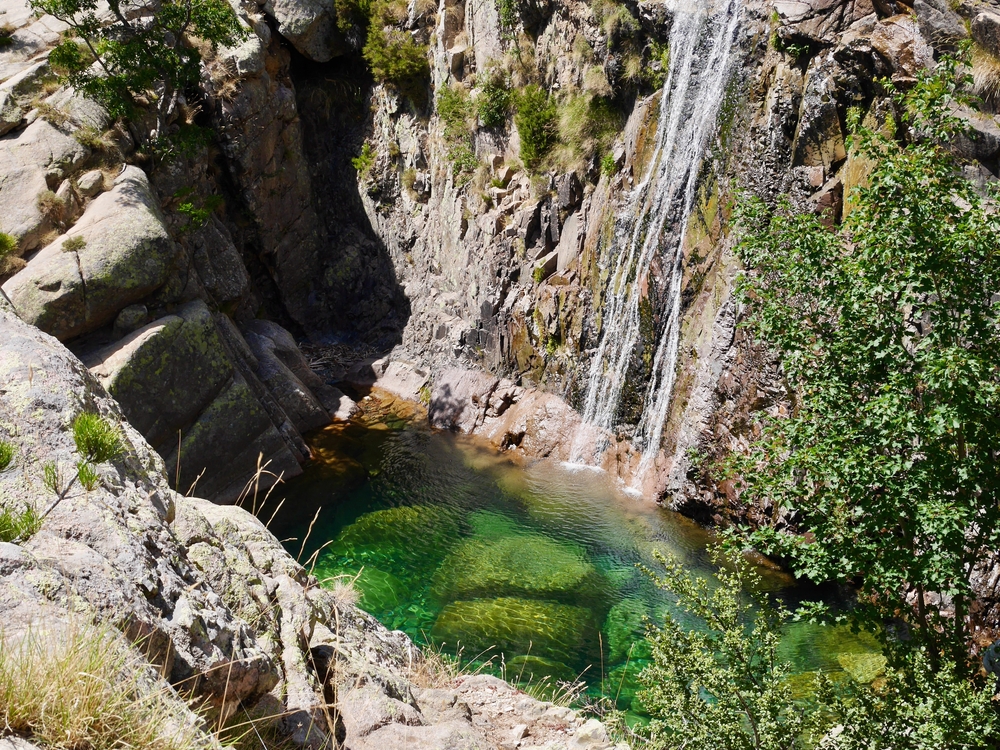
In the heart of the Vergio massif, near the eponymous pass, the Radule waterfall is a popular stop-off point for hikers. This beautiful waterfall on the Golo, Corsica’s longest river, offers an exceptional natural setting with its traditional sheepfolds nearby. The hike to get there is relatively easy and fun, making it ideal for families.
The natural pools formed by the waterfall invite you to take a dip in the cool, pure water. The site is less busy than the waterfalls in the south of the island, so you can enjoy the peace and quiet. The pools, which vary in size, are spread out along the torrent and offer a variety of bathing spots to suit all tastes.
Access: From the Col de Vergio (between Porto and Corte), park at the Fer à Cheval car park. Follow the blue markers from the wooden signpost. After just a 5-minute walk, you’ll see the signs for the waterfall. Allow 20-30 minutes to reach the main site.
9. The Richiusa gorges
Situated near Bocognano, the Richiusa gorges are renowned for their wild beauty and numerous opportunities for swimming. This spectacular canyon, carved out of the Migliarella granite massif, offers a succession of natural pools that can be crossed by slides. The site is particularly popular for canyoning, but the first pools are still accessible to simple bathers.
The foam created by the waterfalls adds a playful aspect to the bathing experience, to the delight of young and old alike. The remarkably pure water meanders between polished rocks, forming pools of varying depths. For the full experience, head for the start of the gorge, where the natural spectacle is particularly impressive.
Access: The gorge lies 3.5 kilometres north of Bocognano, itself halfway between Ajaccio and Corte on the RN193. From the village, follow the signs for “Richiusa”. There is a car park where you can park before taking the path leading to the gorges.
10. The Fango Valley
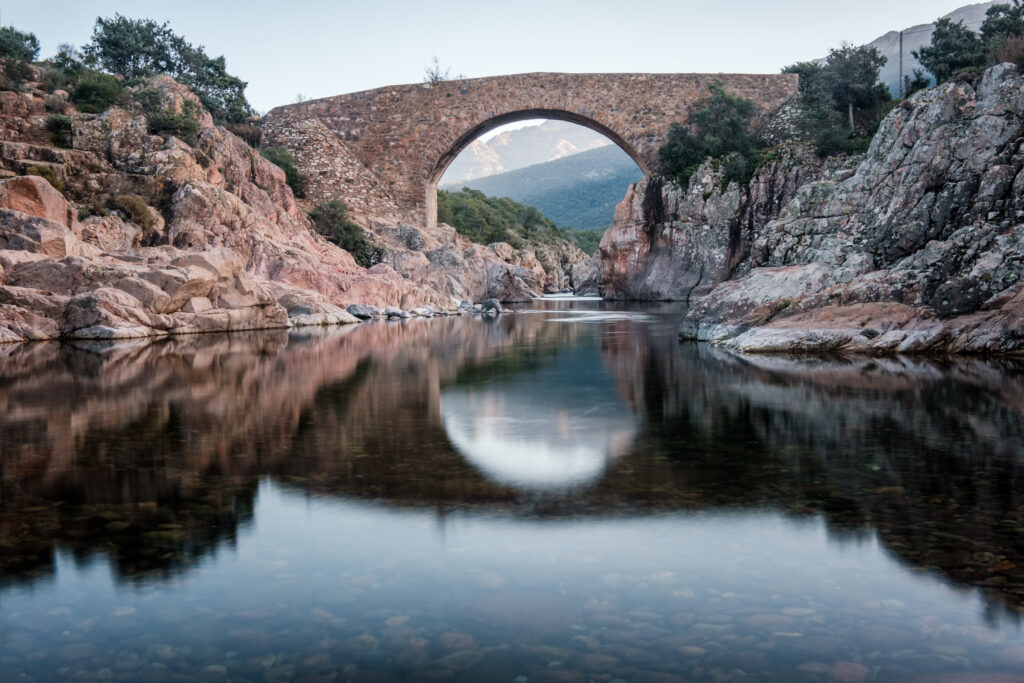
Classified as a biosphere reserve by UNESCO, the Fango valley is one of the last wild spaces in the Mediterranean. This coastal river of Haute-Corse has carved countless natural pools and water slides into the varied-coloured rocks along its course. The crystal-clear waters of the Fango are slightly gentler than those of other Corsican rivers, making for ideal bathing conditions.
The valley stretches for some thirty kilometres, dotted with swimming spots, each more beautiful than the last. The turquoise pools contrast magnificently with the red granite rocks. The most popular spot is at the Tuvarelli bridge, which is easily accessible and offers several deep pools for swimming. The valley is also home to some remarkable wildlife: keep an eye out for Corsican mouflon and golden eagles.
Access: The Fango valley lies 32 kilometres south of Calvi, accessible from Galeria. There are several access points along the road that runs alongside the river. The Biscuiterie bridge in the hamlet of Mantestremo (commune of Manso) offers easy access via a staircase on the right after the bridge.
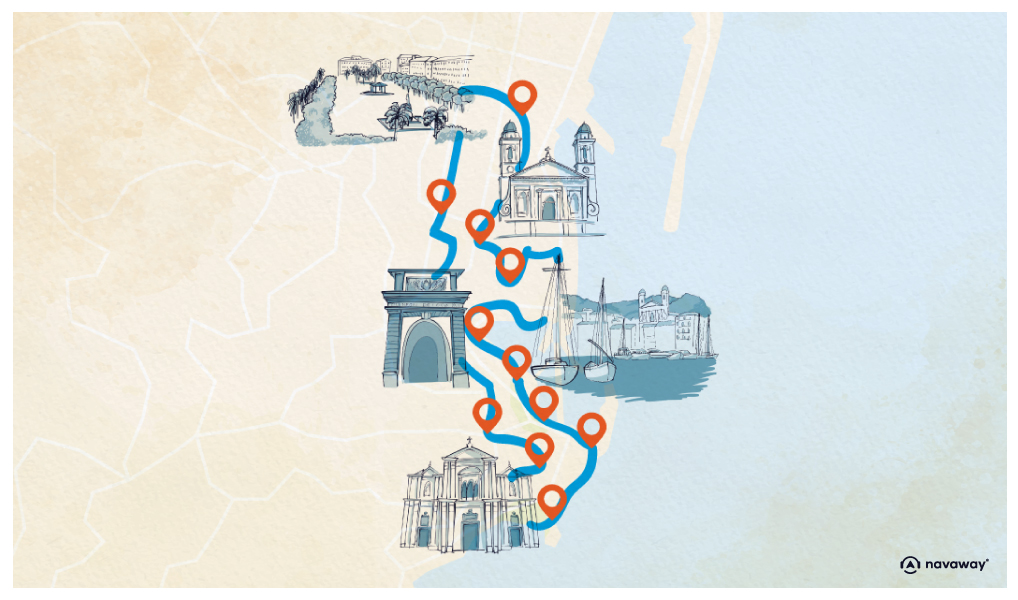
In conclusion, Corsica has a wealth of natural treasures to offer freshwater bathing enthusiasts. From the majestic Purcaraccia waterfalls to the secret pools of the Fango valley, each site offers a unique experience in the heart of unspoilt nature. Whether you’re visiting Ajaccio, Bastia or Corte, don’t hesitate to venture into the hinterland to discover these aquatic wonders. Remember to respect these fragile natural areas by taking your rubbish with you and following the regulations in force, especially in high season. With its crystal-clear waters, imposing landscapes and wild nature, the Isle of Beauty promises unforgettable moments of freshness and wonder. To help you organise your stay, take a look at our audio-guided tours of Corsica, which will allow you to explore the island’s towns and villages on your own.
FAQ – Waterfalls of Corsica
When is the best time to visit Corsica’s waterfalls?
The best period is from May to September. In spring (May-June), the waterfalls are more impressive thanks to the high flow of snowmelt, but the water is colder. In summer (July-August), the water is warmer but the sites are busier. Choose June and September for a good compromise between water temperature, waterfall flow and tourist numbers.
Do I need a guide to get to the waterfalls?
Some waterfalls, such as Purcaraccia and Polischellu, are regulated by prefectoral decree between 1 July and 15 September. During this period, access may require the presence of an approved professional guide. Outside this period, access to the other waterfalls is generally free. Always check the conditions of access before your visit.
How hot is the water in Corsica’s waterfalls?
Water temperature varies according to altitude and season. In mountain waterfalls like Purcaraccia, the water stays cool all year round, between 12 and 15 degrees. In mid-altitude rivers such as the Cavu or the Fango, the water can reach 18 to 20 degrees at the height of summer. Always bring a towel and warm clothes after swimming.
Are the waterfalls accessible to children?
Some waterfalls, such as the Cavu pools or the first pools in the Restonica gorges, are ideal for families with children. Others, such as Purcaraccia or Piscia di Gallo, require a more strenuous hike. Always check the difficulty of the access route and the bathing conditions before setting off with children. Favour sites with little current for younger children.
What should you pack for a day at the waterfalls?
Bring suitable hiking boots (the terrain can be slippery), a swimming costume, towel, sun cream, hat, plenty of water and something to eat. Don’t forget to bring a bag for your rubbish to preserve the beauty of these natural sites. Water shoes may be useful for walking in the rocky rivers.
200 audioguided tours for cities all around the world
Download